Back in the days of 500cc Grand Prix racing, spinning the rear wheel as you exited corners was an essential skill. These days, we don’t see it much, with a few notable exceptions. Why is that? Are electronics to blame once again, or is there some other reason why riders favour backing it in over sliding it out?
We’ve seen many different approaches to cornering on a motorcycle over the years. Knee-up, knee-down, hanging-off and sitting bolt upright and, of course, Mick Doohan’s unique ‘all of the above’ approach. And to be fair, each method works in one way or another. However, there’s one style of cornering that has simultaneously terrified and amazed racing audiences for as long as most people can remember – sliding the rear end. So why are so few riders doing it these days?
Take two very different riders like Jorge Lorenzo and Marc Márquez. It is well known that Yamaha bury tiny rails in the track before each MotoGP round, which is why Lorenzo’s bike never gets out of line. On the other hand, Márquez doesn’t mind lighting up the rear at any opportunity. It’s important to recognise that this is only our perception, though. Watch closely and you’ll notice that he doesn’t drift the rear out of every corner. It’s not like watching a speedway race. And that’s important, because it suggests that it’s something he’s choosing to do. If it was down to a lack of grip, everyone would be spinning. If it was his riding style or it was something to do with the bike, it would happen at every single corner.
So what makes bikes corner? Leaning for a start, but that isn’t the exclusive reason. What about steering; everyone knows about counter steering and how it is used to make a bike turn. Geometry? It’s true to say that changing the set-up of a bike changes the way it corners, but a bike that is badly set-up or designed still goes around corners – it just does it slower. In fact, bikes corner for all of the above reasons, and more besides, which is partly why it seems such an unapproachable subject.
Let’s start by looking at steering. Most bikes have a steering range of ±20–35°, but it’s rare to use that much in ‘normal’ riding conditions. In fact on a normal road ride it would be unusual to use much more than ±15° – and that’s pulling out of junctions. On track, it’s even less. If we ignore the fact that bikes lean for a moment and just look at the steering, what happens when you turn the bars? The front wheel points in a different direction to the frame and rear wheel plane and leans slightly. If we slowly push the bike forwards it’s easy to appreciate the fact that the bike is going to move in a circle because the front wheel is steering it to.
The radius of that circle can be found by drawing an extended line through both wheel spindles in the direction of the turn. The point where the two lines cross marks the centre of that circle – the point about which the bike will turn. It’s worth emphasising that this only holds true at very low speeds, and only when the bike is upright. It’s also important to recognise that while we may be pushing the bike at a constant speed as far as the speedo is concerned, the bike’s velocity vector has changed because it’s accelerating towards the centre of the circle. It has to be.
Newton told us bodies in motion carry on in a straight line unless some force causes them not to.
In this case, a force generated at the front tyre by the steering is pushing it sideways. We can work out how much acceleration there is by squaring the velocity and dividing it by the radius of the turn. If we look at a real world example, the radius of the ridden line at the apex of Donington’s Melbourne loop (not the track itself), is about 20 metres. And at the apex of that turn you can expect a true speed over ground of around 49km/h. To work out the bike’s lateral acceleration at that point we square the velocity (in metres per second) and divide by the radius v2/r. That works out as an acceleration of 9.262m/s2, which we can turn into g by dividing it by 9.81m/s2, which works out at 0.94g.
But if you’ve watched bikes cornering at the Melbourne loop you’ll know they’re really on their side – and there’s a good reason for this. At less than walking pace, a bike can turn without any perceivable lean angle simply by turning the steering. Any faster though and the bike wants to fall ‘out’ of the corner. This is because it’s balanced above the tyre contact points. If something causes them to accelerate sideways, they move out from under the bike and it appears to fall the other way.
Sticking with the Melbourne loop example, the contact points are trying to accelerate towards the inside of the corner at 9.262m/s2. But there’s no lateral force trying to push the bike’s centre of mass to one side too. So to create that force we lean the bike into the corner. As the bike’s centre of mass is no longer above the line drawn between the contact patches, the bike tries to fall that way. The ‘falling force’ is proportional to the centre of mass’s horizontal displacement from the contact patch. In other words, the more the bike leans, the more it wants to fall. This is good because the faster we go, or the tighter the radius of turn we make, the more the tyres try to accelerate away from under us. It follows then that the more cornering force we generate at the tyres, the more we need to lean to balance it out.
We can work out the lean angle based on the lateral acceleration of the tyres and the vertical acceleration caused by gravity by finding the arctangent of the lateral acceleration (in g). In the case of the Melbourne Loop bike that works out at 43.23° (Tan–1[0.94] = 43.23). So in order for our bike not to flip out of the corner, it needs to be leaning at 43.23°. This might sound low if you’ve ever watched a bike go round the Melbourne Loop, but the 43.23° we’re talking about is not measured through the plane of the wheels, it’s measure on a plane coincident with the combined centre of mass and both tyre contact points.
This happens because when you lean a bike over the contact point moves away from the centre line of the tyre towards the edge. In reality, this means that unless we were riding on thin discs of metal, the lean angle between the centre of mass and the contact points will always be less than the lean angle through the bike’s chassis. And the wider the tyres, the worse that gets.
While we’re on the subject of lean, there are two more things to consider. The first is that when we lean, the force that causes the tyres to accelerate sideways is no longer caused by steering with the bars (actually it is a little bit, but not like when the bike was upright) – it’s generated by camber thrust from the tyres.
Camber thrust comes about because the tyre deforms as it’s pressed into the track surface. Viewed from the rear, the distance from the outer edge of the contact patch (closest to the edge of the tyre) to the wheel spindle will always be less than the distance from the inside edge to the wheel spindle. As the tyre has to turn with the wheel, this means the edge of the contact patch with the larger radius is going to try to cover ground per wheel revolution more quickly than the edge with the smaller radius. And the only way it can attempt to do this is to turn about some axis.
The axis it tries to turn about is actually the same as if you replaced the tyre with a cone that hit the floor in the same spot as the contact patch. And if you imagine where the point of that would be, that’s where the tyre would like to rotate around. But it can’t. Not least because there’s another tyre at the other end of the bike trying to do the same thing, but also because for the lean angles we deal with, the radius of that turn would be impossibly tight. So what happens is a massive compromise that creates slip within the contact patch itself and that is also part of the reason why tyres tear up in the way that they do.
From a riding point of view, though, the speed you go round a corner is limited by grip, which is controlled by the tyre and the surface it’s rolling over. In order to get round a corner, we need to generate enough lateral acceleration for the bike to follow an arc that keeps us on the track and out of the gravel. Most of the cornering force comes from camber thrust created by leaning, which is good as the bike needs to lean over in order not to be flipped out of the corner. The steering will turn slightly into the corner based on the lean angle, geometry and tyre size, and that also creates some input.
When things go well, we hit the line we want. But it’s important to recognise that, even though you don’t feel it, the bike is slipping slightly all the time. So, although you’re on the right line, the bike is trying to turn on a tighter one but is slipping out to the correct one. As you get close to the tyres’ grip limit, the amount of slip increases and you get the sensation of drifting off line. If the grip at one wheel suddenly increases faster than the other you begin the process of what can become a high- or low-side.
If we go back to the question on sliding or not, the question really becomes, how do I get the bike where I want it? The simple answer is to steer it like anyone else, but racers sometimes need to hold a tighter line – to get the bike lined up for the next corner, for example. This is where rear-wheel steering comes in. Because when a bike is really wheel steering, things almost work backwards.
Think about it like this: although the steering angle at the bars reduces the faster we go, the front wheel of our bike still has some input when we corner because it points into the corner. As the rear end drifts outwards, we actually end up with a negative steer angle at the front (because the front wheel is pointing in the direction of travel it is negative compared to the plane of the rear wheel). However, the rear wheel is now pointing and leaning much more in the direction of the turn – and has more weight on it because we’ve applied power to get it to spin. The weight, angle and camber of the rear wheel mean it’s responsible for the majority of the lateral acceleration, which is also now linked to the normal rotation of the wheel as that’s pointing towards the inside of the turn.
When exiting a corner and holding a tight line ready for the next one, having the rear wheel sliding out means much of the cornering force is controlled by the throttle (rather than leaning and using the bars). It risks a crash, of course, and gives the tyre a harder time, but if a rider feels the time/effort saved is worth it, that’s what they’ll do.
As for which is faster… that’s a tricky question, especially these days when there are tens of thousands of pounds of technology being used to prevent the rear wheel sliding. The simple answer is that it depends on the rider – not their talent, their confidence. They have to be sure of both the chassis and engine, and to be confident that the advantage outweighs the consequences. That’s the most likely reason we don’t see it as much as we used to. It’s hard to get the engineers to disable systems that work so well, because by leaving them on and riding at the controlled limit of adhesion means all the other factors can be managed effectively over the course of the race. It takes a confident rider to argue against that.


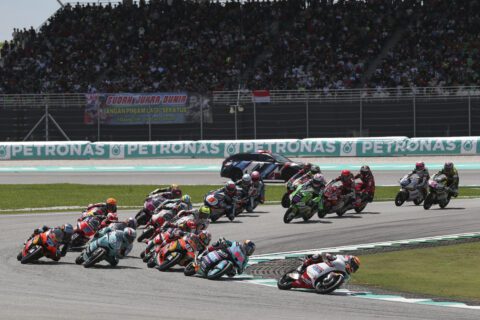
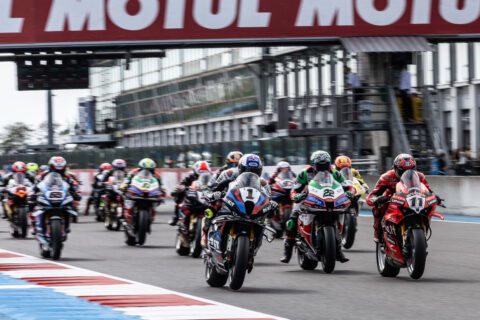
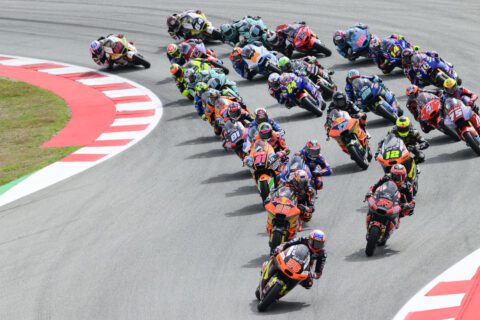
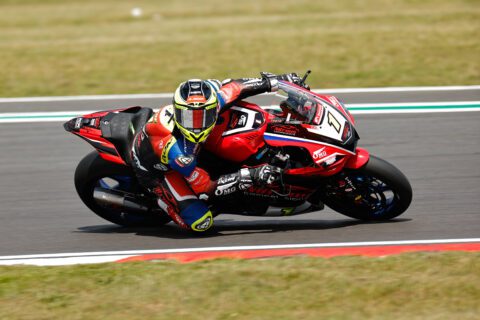
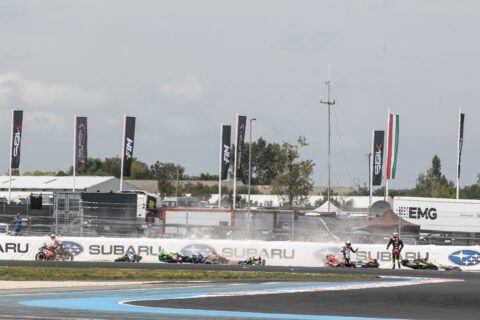
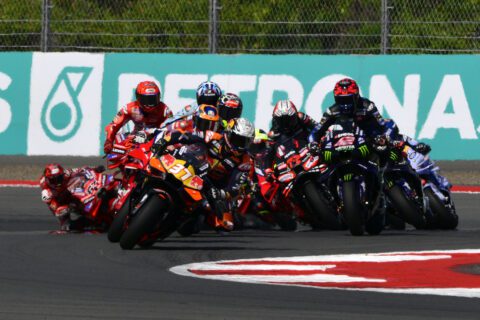
![Shane Byrne, Monstermob Ducati, 2003 WorldSBK, action [Gold & Goose]](https://bikesportnews.com/wp-content/uploads/2025/07/Shane-Byrne-Monstermob-Ducati-2003-WorldSBK-action-Gold-Goose-480x272.jpg)

